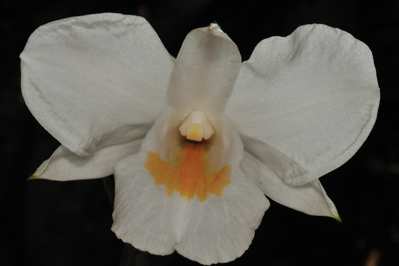Epiphyte. Stems erect, slender, long as 15 to 35 cm, with narrow thickening nodes. Leaves linear-lanceolate, 3 to 5 cm long and 1.5 cm in width, apex acute. Flowers 2 to 3 cm across, in pairs from the nodes of leafless stems. Sepals white; petals white flushed with pink; lip white except at its undulate apical lobe which is flushed with pink on its exterior, the disc with a large purple patch and its convolute sides with many streaks of purple. Sepals lanceolate, acute. Petals of the same length as that of petals, ovate and with almost blunt apices. Lip long as sepals, elliptic-obovate, clawed at the base, side lobes convolute, the terminal lobe sub-orbicular with undulate edges.

The Pursuit
When in bloom, this plant attracts the attention of all passing by. It is still fresh in my mind, the first time I saw this plant in bloom. It was inside a tea estate in the plains of the region. The estate was carpeted for miles and miles with fresh grown green leaves. The plant was on the top branch of a dried tree, with many full bloom flowers on leafless erect stems with the blue sky as background. It was one of the amazing sites of my flower hunts.
The plant is a common species of the tropics. Its erect stems are always an easy identification mark. I found this plant two years back during my routine survey and waited for its blooming time. After the first monsoon shower, buds started appearing and it bloomed in the second week. The tree in which I spotted this species was an almost dead and there was a possibility of it falling down soon. My first intention was to protect the tree from falling down, thus saving the habitat of this species. With the help of the estate manager and his workers we fixed five 15 ft tall wooden poles around the tree and tied them with iron wires. The nature enthusiast manager promised to give similar help for any trees in his territory. I was lifted up to the top of the tree on the blade of an earth mover to further safe guard the tree as well as me and my equipments. The close up view of this flower was more amazing. With its pure white petals and pink flushed sepals I think this is the most beautiful Dendrobium flower of the tropics. I was even more happy to have a wonderful position on the blade of the earth mover and produced this wonderful photograph with its pale colour variation well recorded.








